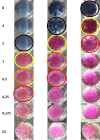Overestimation of Amphotericin B Resistance in Candida auris with Sensititre YeastOne Antifungal Susceptibility Testing: a Need for Adjustment for Correct Interpretation
- PMID: 37036351
- PMCID: PMC10269614
- DOI: 10.1128/spectrum.04431-22
Overestimation of Amphotericin B Resistance in Candida auris with Sensititre YeastOne Antifungal Susceptibility Testing: a Need for Adjustment for Correct Interpretation
Abstract
Significant variation in minimal inhibitory concentrations (MIC) has been reported for amphotericin B (AMB) and C. auris, depending on the antifungal susceptibility testing (AFST) method. Although the Sensititre YeastOne (SYO) is widely used in routine laboratory testing, data regarding its performance for the AFST of C. auris are scarce. We tested AMB against 65 C. auris clinical isolates with the SYO and the reference methodology by the Clinical and Laboratory Standards Institute (CLSI). The essential agreement (EA, ±1 dilution) between the two methods and the categorical agreement (CA) based on the Centers for Disease Control and Prevention (CDC)'s tentative breakpoint of MIC ≥ 2 mg/L were determined. The SYO wild type upper limit value (WT-UL) was determined using the ECOFFinder. The modal (range) CLSI growth inhibitory MIC was lower than the SYO colorimetric MIC [1(0.25-1) versus 2(1-8) mg/L, respectively]). The CLSI-colorimetric SYO EA was 29% and the CA was 11% (89% major errors; MaE). MaE were reduced when the SYO WT-UL of 8 mg/L was used (0% MaE). Alternatively, the use of SYO growth inhibition endpoints of MIC-1 (75% growth inhibition) or MIC-2 (50% growth inhibition) resulted in 88% CA with 12% MaE and 97% CA with 3% MaE, respectively. In conclusion, SYO overestimated AMB resistance in C. auris isolates when colorimetric MICs, as per SYO instructions and the CDC breakpoint of 2 mg/L, were used. This can be improved either by using the method-specific WT-UL MIC of 8 mg/L for colorimetric MICs or by determining growth inhibition MIC endpoints, regardless of the color. IMPORTANCE Candida auris is an emerging and frequently multidrug-resistant fungal pathogen that accounts for life-threatening invasive infections and nosocomial outbreaks worldwide. Reliable AF is important for the choice of the optimal treatment. Commercial methods are frequently used without prior vigorous assessment. Resistance to AMB was over-reported with the commercial colorimetric method Sensititre YeastOne (SYO). SYO produced MICs that were 1 to 2 twofold dilutions higher than those of the reference CLSI method, resulting in 89% MaE. MaE were reduced using a SYO-specific colorimetric wild type upper limit MIC value of 8 mg/L (0%) or a 50% growth inhibition endpoint (3%).
Keywords: Candida auris; Sensititre YeastOne; amphotericin B; antifungal susceptibility testing; epidemiological cutoff value; resistance; wild type upper limit value.
Conflict of interest statement
The authors declare no conflict of interest.
Figures



Similar articles
-
Candida auris - Comparison of sensititre YeastOne and Vitek 2 AST systems for antifungal susceptibility testing - A single centre experience.Indian J Med Microbiol. 2024 Jul-Aug;50:100618. doi: 10.1016/j.ijmmb.2024.100618. Epub 2024 May 30. Indian J Med Microbiol. 2024. PMID: 38795936
-
Outbreak of Candida auris in Spain: A comparison of antifungal activity by three methods with published data.Int J Antimicrob Agents. 2019 May;53(5):541-546. doi: 10.1016/j.ijantimicag.2019.02.005. Epub 2019 Feb 12. Int J Antimicrob Agents. 2019. PMID: 30769198
-
Comparative evaluation of sensititre YeastOne and VITEK2 antifungal susceptibility tests with CLSI broth microdilution method of clinical Cryptococcus isolates in Taiwan.Microbiol Spectr. 2025 Feb 4;13(2):e0211724. doi: 10.1128/spectrum.02117-24. Epub 2024 Dec 19. Microbiol Spectr. 2025. PMID: 39699241 Free PMC article.
-
Candida and candidaemia. Susceptibility and epidemiology.Dan Med J. 2013 Nov;60(11):B4698. Dan Med J. 2013. PMID: 24192246 Review.
-
Candida auris and multidrug resistance: Defining the new normal.Fungal Genet Biol. 2019 Oct;131:103243. doi: 10.1016/j.fgb.2019.103243. Epub 2019 Jun 20. Fungal Genet Biol. 2019. PMID: 31228646 Free PMC article. Review.
Cited by
-
An Acute Gangrenous Cholecystitis Caused by Candida auris: A Case From a Greek Hospital.Cureus. 2024 Oct 12;16(10):e71338. doi: 10.7759/cureus.71338. eCollection 2024 Oct. Cureus. 2024. PMID: 39534840 Free PMC article.
-
Candida auris MIC testing by EUCAST and clinical and laboratory standards institute broth microdilution, and gradient diffusion strips; to be or not to be amphotericin B resistant?Clin Microbiol Infect. 2025 Jan;31(1):108-112. doi: 10.1016/j.cmi.2024.10.010. Epub 2024 Oct 18. Clin Microbiol Infect. 2025. PMID: 39426481 Free PMC article.
-
Spectrum and management of rare Candida/yeast infections in Kuwait in the Middle East.Ther Adv Infect Dis. 2024 Jul 24;11:20499361241263733. doi: 10.1177/20499361241263733. eCollection 2024 Jan-Dec. Ther Adv Infect Dis. 2024. PMID: 39070702 Free PMC article. Review.
-
The multidrug-resistant Candida auris, Candida haemulonii complex and phylogenetic related species: Insights into antifungal resistance mechanisms.Curr Res Microb Sci. 2025 Jan 28;8:100354. doi: 10.1016/j.crmicr.2025.100354. eCollection 2025. Curr Res Microb Sci. 2025. PMID: 39995443 Free PMC article. Review.
-
The Micronaut-AM antifungal susceptibility testing method does not overestimate amphotericin B resistance in Candida auris.Microbiol Spectr. 2024 May 2;12(5):e0049024. doi: 10.1128/spectrum.00490-24. Epub 2024 Apr 5. Microbiol Spectr. 2024. PMID: 38578100 Free PMC article. No abstract available.
References
-
- Rybak JM, Barker KS, Muñoz JF, Parker JE, Ahmad S, Mokaddas E, Abdullah A, Elhagracy RS, Kelly SL, Cuomo CA, Rogers PD. 2022. In vivo emergence of high-level resistance during treatment reveals the first identified mechanism of amphotericin B resistance in Candida auris. Clin Microbiol Infect 28:838–843. doi:10.1016/j.cmi.2021.11.024. - DOI - PMC - PubMed
-
- Ostrowsky B, Greenko J, Adams E, Quinn M, O’Brien B, Chaturvedi V, Berkow E, Vallabhaneni S, Forsberg K, Chaturvedi S, Lutterloh E, Blog D, Bucher C, Denis RJ, Erazo R, Fernandez R, Southwick K, Zhu YC, Group C auris IW, Group C auris IW . 2020. Candida auris isolates resistant to three classes of antifungal medications — New York, 2019. MMWR Morb Mortal Wkly Rep 69:6–9. doi:10.15585/mmwr.mm6901a2. - DOI - PMC - PubMed
MeSH terms
Substances
LinkOut - more resources
Full Text Sources
Medical

